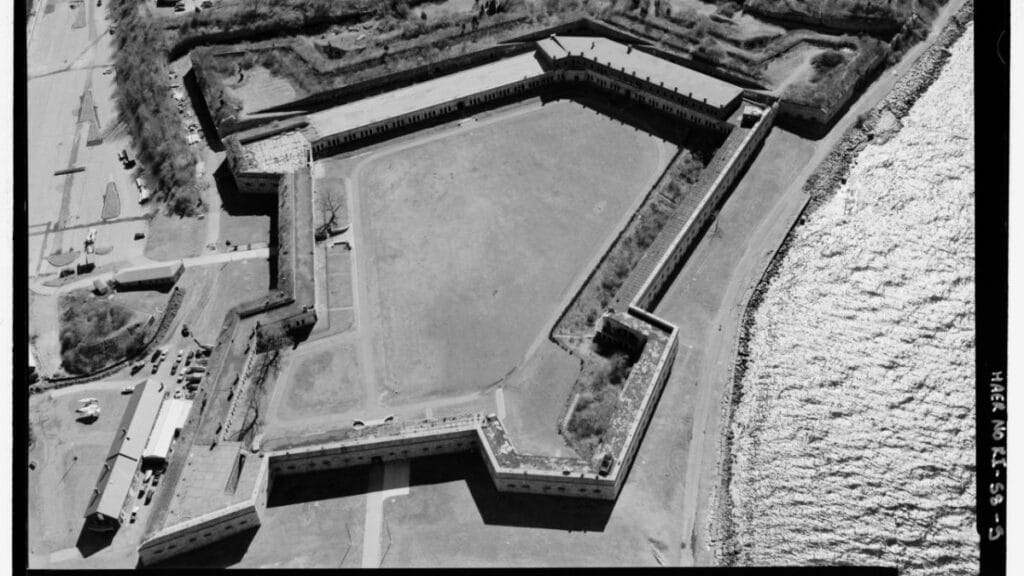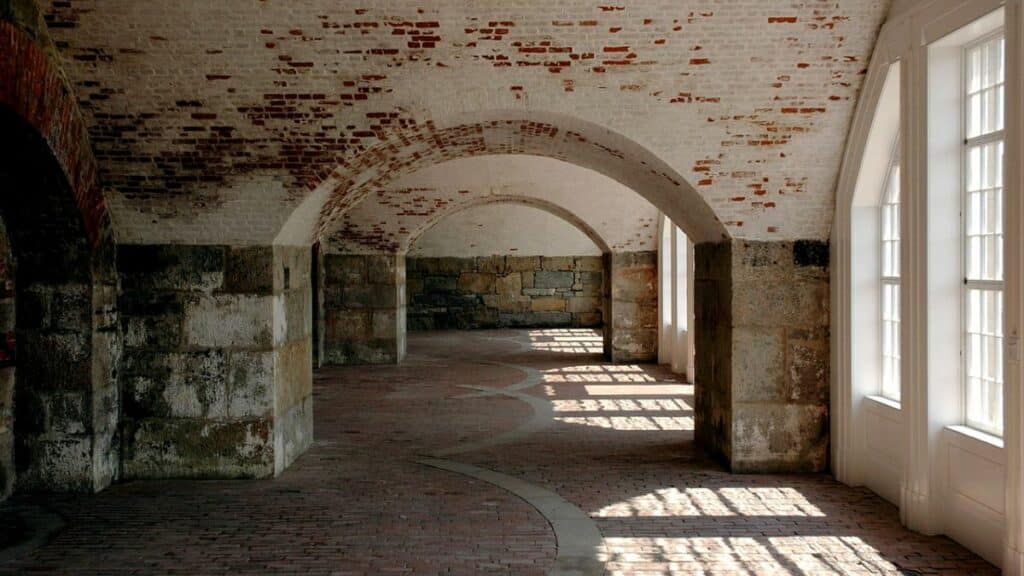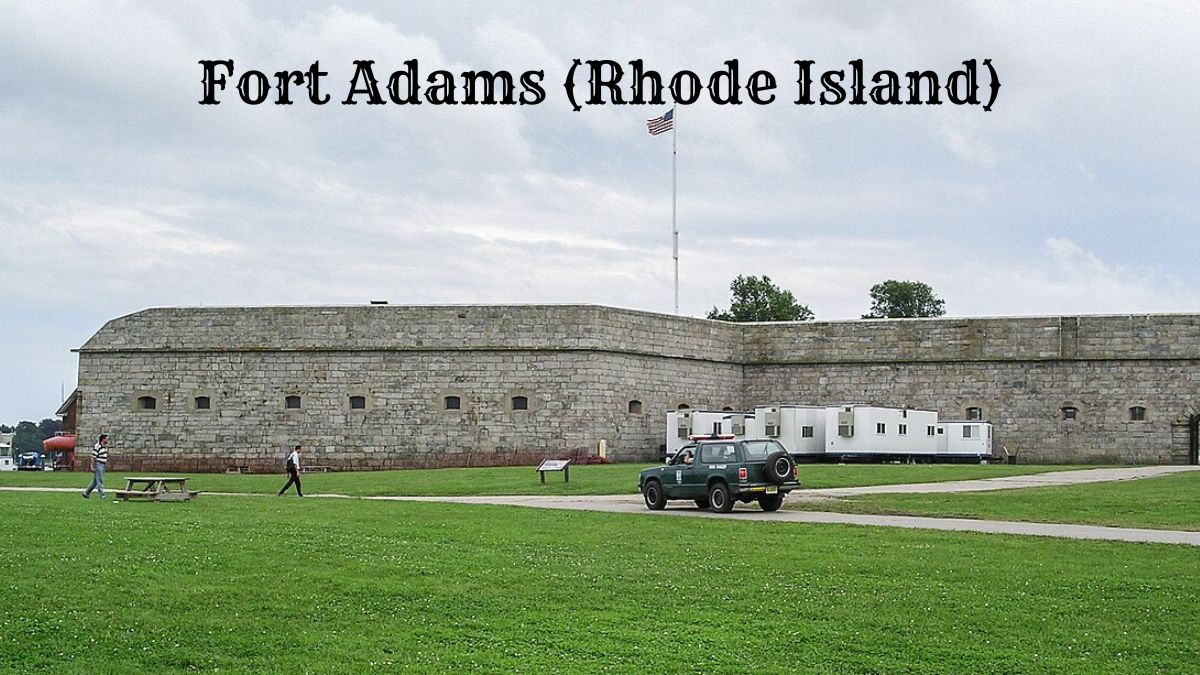Fort Adams is a significant historical landmark in Newport, Rhode Island. Established in 1799, it offers a glimpse into American military history.
Located at the entrance of Narragansett Bay, it played a crucial role in coastal defense.
Visitors to Fort Adams can explore its extensive fortifications and enjoy guided tours.
The surrounding area provides stunning views of Newport Harbor and the bay, making it a popular spot for history enthusiasts and tourists.
Fort Adams is not just about history; it’s a vibrant site that hosts various events and activities throughout the year. Its picturesque setting and rich past make it an indispensable part of Rhode Island’s cultural heritage.
History of Fort Adams (Rhode Island)

Fort Adams in Rhode Island holds immense historical value due to various periods of military involvement that have had lasting impacts. Its designation as a National Historic Landmark highlights its preservation for future generations.
National Historic Landmark
The Fort Adams Trust recognizes Fort Adams as a National Historic Landmark, underlining its importance in American history and heritage.
Built in 1824, the fort was critical in coastal defense operations.
This exceptional status ensures the fort is maintained and protected for its architectural and historical significance.
Preservation efforts focus on maintaining the fort’s original structure while facilitating public education and engagement.
Civil War Role
During the Civil War, Fort Adams served as a key military installation. It was integral to the coastal defense strategy designed to protect the New England area from Confederate forces.
The fort’s strategic location provided a fortified position crucial for monitoring and defending against potential maritime threats.
This period marked a significant phase in the fort’s operational history, reflecting military engineering and defense tactics advancements.
World Wars Involvement
Fort Adams remained a crucial military site through World War I and II.
It served as a training ground and staging area during World War I.
In World War II, its role expanded to include housing anti-aircraft defenses and serving as a command center.
These activities reflect the fort’s adaptability to evolving military needs and technologies.
Its participation in these conflicts underscores its enduring strategic value.
Design and Architecture

Fort Adams is a prime example of historic military engineering, reflecting defensive strategies and architectural skills.
Built with detailed attention to fortifications, its structures reveal the evolution of coastal defense.
Fortifications and Defenses
Fort Adams’ design incorporates robust walls and strategic placements of cannons to withstand attacks.
Its architecture includes multiple layers of defenses, such as terreplein platforms where guns could be mounted.
Thick granite walls ensure durability and protection, while underground tunnels provide safe passages and storage areas for ammunition.
Surrounding moat and glacis slopes enhance defensibility by hindering enemy approach.
Coastal Fortification Evolution
Built in the early 19th century, Fort Adams illustrates the changes in coastal fortification tactics.
Originally designed to protect against naval threats, its structure was adapted to accommodate artillery and military technology advancements.
The fort’s layout, including bastions and curtain walls, highlights how engineers integrated new defensive innovations while maintaining the fort’s overall integrity.
Battery Reilly
Battery Reilly, a notable feature within Fort Adams, served as an important artillery position.
It was constructed later than the main fort and designed to house more powerful guns.
This battery includes reinforced concrete emplacements for heavy artillery.
Positioned to cover key approaches, it represents the adaptive nature of military architecture responding to evolving threats.
Explore More: 10 Historic Forts in Rhode Island: A Journey Through Time
Daily Life at the Fort Adams
Life at Fort Adams involved a structured daily routine marked by military duties and communal living within the barracks.
Military Garrison Lifestyle
Soldiers at Fort Adams followed a strict schedule.
Daily drills, weapon maintenance, and guard duty were routine tasks ensuring readiness at all times.
Physical training was crucial to maintain fitness.
The day typically began with a bugle call at dawn, followed by physical exercise and breakfast.
Training sessions focused on tactical skills and formation drills.
Free time was limited, but soldiers often enjoyed reading or playing cards to relax.
Barracks and Accommodation
The barracks at Fort Adams housed soldiers in shared quarters.
The rooms were functional but minimalist, usually featuring wooden bunks and storage for personal items.
Heating was provided by wood stoves, which are essential during cold months.
Common areas included mess halls where meals were shared.
Each soldier received a cot, bedding, and storage space for uniforms and equipment.
Community life thrived in these spaces, with soldiers bonding over shared experiences and duties. Small gardens often supplemented their diets with fresh produce.
Visitor Experience

Visitors to Fort Adams can expect diverse activities, fascinating tours, and numerous recreational opportunities. Whether interested in history, music, or outdoor activities, Fort Adams offers something for everyone.
Guided Tours and Activities
Guided tours at Fort Adams offer an in-depth look at this historical site.
Knowledgeable guides lead visitors through the fort’s intricate tunnels, stunning bastions, and scenic overlooks of Narragansett Bay.
Tours often include the Eisenhower House, a key historical residence within the park.
The museum on site provides exhibits on the fort’s rich history and military significance, making it an educational experience for all ages.
Special thematic tours, such as ghost tours, attract many interested in the paranormal.
Events and Festivals
Fort Adams is renowned for hosting prominent events and festivals.
The Newport Folk Festival and Newport Jazz Festival draw music enthusiasts from across the globe.
These events provide world-class performances against the backdrop of Narragansett Bay.
Weddings and other private events can also be arranged within Fort Adams State Park, offering picturesque venues with historical charm.
Seasonal events, such as the summer concert series, add more opportunities for visitors to engage with the site.
Recreational Opportunities
Fort Adams State Park offers a range of recreational activities.
Picnicking areas are available for families and groups, with nearby restroom facilities.
The park’s expansive grounds are perfect for running, walking, and outdoor activities.
Visitors can enjoy panoramic views of the bay while engaging in casual sports or simply relaxing.
The park’s waterfront location makes it a popular spot for fishing and other water-related activities, adding to its appeal for outdoor enthusiasts.
Conservation Efforts
Fort Adams in Rhode Island has seen numerous conservation projects to preserve its historical significance and structural integrity. These efforts, led by dedicated organizations, focus on restoration and ongoing initiatives.
Restoration Projects
Significant restoration projects at Fort Adams aim to preserve the fort’s historic elements and structural stability.
These projects include masonry work on the fort’s walls, replacement of deteriorated wooden beams, and thorough inspections of drainage systems to prevent water damage.
Restoration of the fort’s iconic redoubt, a critical defensive structure, has been prioritized.
The team has also addressed environmental factors, such as removing vegetation from sensitive areas to protect against erosion and further damage to the historic masonry.
Funding for these restoration projects comes from state grants, private donations, and partnerships with historical preservation societies.
The restoration work ensures that the fort remains a valuable educational and tourist site, retaining its historical authenticity.
Fort Adams Trust Initiatives
The Fort Adams Trust plays a significant role in the fort’s conservation efforts.
This organization coordinates volunteer programs, educational tours, and fundraising events to support preservation activities.
The Trust also engages with local schools and community groups to raise awareness about the fort’s historical importance.
Their initiatives include specialized workshops on historic preservation techniques and public lectures on the fort’s history.
They have also developed interactive exhibits within the fort to enhance visitor experience and educational value.
Through these efforts, the Fort Adams Trust ensures the fort remains accessible and informative to the public.
Their dedication helps maintain Fort Adams as a landmark of historical significance for future generations.
Military Engineering
Fort Adams is a prime example of military engineering, with a complex network of tunnels and a formidable array of coastal defense armaments.
Tunnel Systems
Fort Adams is renowned for its intricate tunnel system, which was designed for strategic military use.
These tunnels allowed troops to move undetected and provided vital supply routes.
Key Features:
- Purpose: Conceal troop movements, transport supplies.
- Construction: Utilized granite and bricks.
- Locations: Beneath the fort and connecting key points within.
The tunnels’ strategic positioning enhanced the fort’s defensive capabilities, enabling soldiers to respond swiftly to threats.
Armament and Coastal Defense
Fort Adams was designed to defend against naval attacks and housed various artillery pieces and coastal guns.
Features and Armament:
- Cannons and Artillery: Positioned strategically around the fort.
- Materials: Cast iron and bronze for durability.
- Defensive Structures: Built from stone and earthworks for added protection.
These defensive measures ensured Fort Adams could effectively protect the coastline, demonstrating the fort’s robust military engineering.
Partners and Affiliations
Fort Adams in Rhode Island maintains key collaborations that significantly contribute to community engagement and program effectiveness.
Sail Newport Collaboration
Sail Newport, a public sailing center, partners with Fort Adams to boost sailing and maritime activities.
This collaboration enables the organization of major events, such as regattas and sailing educational programs, contributing to their shared goals of marine education and community engagement.
Key Points:
- Programs: Offers sailing lessons and camps for various skill levels.
- Events: Hosts high-profile sailing events, attracting international competitors.
- Impact: Enhances local tourism and provides educational opportunities in sailing.
Sail Newport’s resources and expertise support Fort Adams in fostering a vibrant maritime culture.
Relationship with Annapolis
Fort Adams also has a noteworthy relationship with Annapolis, focusing on historic preservation and cultural exchanges.
Both entities share common goals in preserving maritime heritage and promoting naval history.
Key Points:
- Cultural Exchange: Facilitates visits and educational programs related to naval history.
- Preservation Efforts: Collaborates on preserving historical artifacts and sites.
- Community Impact: Bridges connections between two historically significant naval communities.
This relationship underscores the mutual dedication to celebrating and preserving naval history for future generations.

Cory is a website owner and content creator who enjoys fishing, history, coin collecting, and sports, among other hobbies. He is a husband and father of four.
Romans 15:4 For whatever was written in former days was written for our instruction, that through endurance and through the encouragement of the Scriptures we might have hope.

